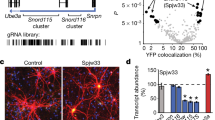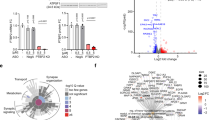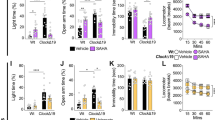Abstract
Angelman syndrome is a severe neurodevelopmental disorder caused by deletion or mutation of the maternal allele of the ubiquitin protein ligase E3A (UBE3A)1,2,3. In neurons, the paternal allele of UBE3A is intact but epigenetically silenced4,5,6, raising the possibility that Angelman syndrome could be treated by activating this silenced allele to restore functional UBE3A protein7,8. Using an unbiased, high-content screen in primary cortical neurons from mice, we identify twelve topoisomerase I inhibitors and four topoisomerase II inhibitors that unsilence the paternal Ube3a allele. These drugs included topotecan, irinotecan, etoposide and dexrazoxane (ICRF-187). At nanomolar concentrations, topotecan upregulated catalytically active UBE3A in neurons from maternal Ube3a-null mice. Topotecan concomitantly downregulated expression of the Ube3a antisense transcript that overlaps the paternal copy of Ube3a9,10,11. These results indicate that topotecan unsilences Ube3a in cis by reducing transcription of an imprinted antisense RNA. When administered in vivo, topotecan unsilenced the paternal Ube3a allele in several regions of the nervous system, including neurons in the hippocampus, neocortex, striatum, cerebellum and spinal cord. Paternal expression of Ube3a remained elevated in a subset of spinal cord neurons for at least 12 weeks after cessation of topotecan treatment, indicating that transient topoisomerase inhibition can have enduring effects on gene expression. Although potential off-target effects remain to be investigated, our findings suggest a therapeutic strategy for reactivating the functional but dormant allele of Ube3a in patients with Angelman syndrome.
This is a preview of subscription content, access via your institution
Access options
Subscribe to this journal
Receive 51 print issues and online access
$199.00 per year
only $3.90 per issue
Buy this article
- Purchase on Springer Link
- Instant access to full article PDF
Prices may be subject to local taxes which are calculated during checkout



Similar content being viewed by others
References
Kishino, T., Lalande, M. & Wagstaff, J. UBE3A/E6-AP mutations cause Angelman syndrome. Nature Genet. 15, 70–73 (1997)
Matsuura, T. et al. De novo truncating mutations in E6-AP ubiquitin-protein ligase gene (UBE3A) in Angelman syndrome. Nature Genet. 15, 74–77 (1997)
Sutcliffe, J. S. et al. The E6-Ap ubiquitin-protein ligase (UBE3A) gene is localized within a narrowed Angelman syndrome critical region. Genome Res. 7, 368–377 (1997)
Albrecht, U. et al. Imprinted expression of the murine Angelman syndrome gene, Ube3a, in hippocampal and Purkinje neurons. Nature Genet. 17, 75–78 (1997)
Rougeulle, C., Glatt, H. & Lalande, M. The Angelman syndrome candidate gene, UBE3A/E6-AP, is imprinted in brain. Nature Genet. 17, 14–15 (1997)
Vu, T. H. & Hoffman, A. R. Imprinting of the Angelman syndrome gene, UBE3A, is restricted to brain. Nature Genet. 17, 12–13 (1997)
Mabb, A. M., Judson, M. C., Zylka, M. J. & Philpot, B. D. Angelman syndrome: insights into genomic imprinting and neurodevelopmental phenotypes. Trends Neurosci. 34, 293–303 (2011)
Peters, S. U. et al. Double-blind therapeutic trial in Angelman syndrome using betaine and folic acid. Am. J. Med. Genet. 152A, 1994–2001 (2010)
Chamberlain, S. J. & Brannan, C. I. The Prader–Willi syndrome imprinting center activates the paternally expressed murine Ube3a antisense transcript but represses paternal Ube3a. Genomics 73, 316–322 (2001)
Landers, M. et al. Regulation of the large (approximately 1000 kb) imprinted murine Ube3a antisense transcript by alternative exons upstream of Snurf/Snrpn. Nucleic Acids Res. 32, 3480–3492 (2004)
Numata, K., Kohama, C., Abe, K. & Kiyosawa, H. Highly parallel SNP genotyping reveals high-resolution landscape of mono-allelic Ube3a expression associated with locus-wide antisense transcription. Nucleic Acids Res. 39, 2649–2657 (2011)
Nakatani, J. et al. Abnormal behavior in a chromosome-engineered mouse model for human 15q11-13 duplication seen in autism. Cell 137, 1235–1246 (2009)
Jiang, Y. H. et al. Mutation of the Angelman ubiquitin ligase in mice causes increased cytoplasmic p53 and deficits of contextual learning and long-term potentiation. Neuron 21, 799–811 (1998)
Miura, K. et al. Neurobehavioral and electroencephalographic abnormalities in Ube3a maternal-deficient mice. Neurobiol. Dis. 9, 149–159 (2002)
Dindot, S. V., Antalffy, B. A., Bhattacharjee, M. B. & Beaudet, A. L. The Angelman syndrome ubiquitin ligase localizes to the synapse and nucleus, and maternal deficiency results in abnormal dendritic spine morphology. Hum. Mol. Genet. 17, 111–118 (2008)
Rougeulle, C., Cardoso, C., Fontes, M., Colleaux, L. & Lalande, M. An imprinted antisense RNA overlaps UBE3A and a second maternally expressed transcript. Nature Genet. 19, 15–16 (1998)
Runte, M. et al. The IC-SNURF–SNRPN transcript serves as a host for multiple small nucleolar RNA species and as an antisense RNA for UBE3A. Hum. Mol. Genet. 10, 2687–2700 (2001)
Watanabe, Y. et al. Genome-wide analysis of expression modes and DNA methylation status at sense-antisense transcript loci in mouse. Genomics 96, 333–341 (2010)
Pommier, Y. Topoisomerase I inhibitors: camptothecins and beyond. Nature Rev. Cancer 6, 789–802 (2006)
Hertzberg, R. P. et al. Modification of the hydroxy lactone ring of camptothecin: inhibition of mammalian topoisomerase I and biological activity. J. Med. Chem. 32, 715–720 (1989)
Plaschkes, I., Silverman, F. W. & Priel, E. DNA topoisomerase I in the mouse central nervous system: age and sex dependence. J. Comp. Neurol. 493, 357–369 (2005)
Scheffner, M., Nuber, U. & Huibregtse, J. M. Protein ubiquitination involving an E1–E2–E3 enzyme ubiquitin thioester cascade. Nature 373, 81–83 (1995)
Beaudenon, S., Dastur, A. & Huibregtse, J. M. Expression and assay of HECT domain ligases. Methods Enzymol. 398, 112–125 (2005)
Kumar, S., Kao, W. H. & Howley, P. M. Physical interaction between specific E2 and Hect E3 enzymes determines functional cooperativity. J. Biol. Chem. 272, 13548–13554 (1997)
Bressler, J. et al. The SNRPN promoter is not required for genomic imprinting of the Prader-Willi/Angelman domain in mice. Nature Genet. 28, 232–240 (2001)
Reik, W. Stability and flexibility of epigenetic gene regulation in mammalian development. Nature 447, 425–432 (2007)
Gammon, D. C. et al. Intrathecal topotecan in adult patients with neoplastic meningitis. Am. J. Health Syst. Pharm. 63, 2083–2086 (2006)
Greer, P. L. et al. The Angelman syndrome protein Ube3A regulates synapse development by ubiquitinating arc. Cell 140, 704–716 (2010)
Lyu, Y. L. et al. Role of topoisomerase IIβ in the expression of developmentally regulated genes. Mol. Cell. Biol. 26, 7929–7941 (2006)
Bomgaars, L., Berg, S. L. & Blaney, S. M. The development of camptothecin analogs in childhood cancers. Oncologist 6, 506–516 (2001)
Cushman, M. et al. Synthesis of new indeno[1,2-c]isoquinolines: cytotoxic non-camptothecin topoisomerase I inhibitors. J. Med. Chem. 43, 3688–3698 (2000)
Nagarajan, M. et al. Synthesis and evaluation of indenoisoquinoline topoisomerase I inhibitors substituted with nitrogen heterocycles. J. Med. Chem. 49, 6283–6289 (2006)
Abramoff, M. D., Magelhaes, P. J. & Ram, S. J. Image processing with ImageJ. Biophotonics International 11, 36–42 (2004)
Lamprecht, M. R., Sabatini, D. M. & Carpenter, A. E. CellProfiler: free, versatile software for automated biological image analysis. Biotechniques 42, 71–75 (2007)
Tsai, T. F., Jiang, Y. H., Bressler, J., Armstrong, D. & Beaudet, A. L. Paternal deletion from Snrpn to Ube3a in the mouse causes hypotonia, growth retardation and partial lethality and provides evidence for a gene contributing to Prader-Willi syndrome. Hum. Mol. Genet. 8, 1357–1364 (1999)
Peery, E. G., Elmore, M. D., Resnick, J. L., Brannan, C. I. & Johnstone, K. A. A targeted deletion upstream of Snrpn does not result in an imprinting defect. Mamm. Genome 18, 255–262 (2007)
Fairbanks, C. A. Spinal delivery of analgesics in experimental models of pain and analgesia. Adv. Drug Deliv. Rev. 55, 1007–1041 (2003)
Pierce, A. A. & Xu, A. W. De novo neurogenesis in adult hypothalamus as a compensatory mechanism to regulate energy balance. J. Neurosci. 30, 723–730 (2010)
Acknowledgements
We thank A. Beaudet and Y.-h. Jiang for providing Ube3a–YFP and Ube3am–/p+ mice; T. Riday and J. E. Han for assistance in i.c.v. mini-osmotic pump infusion; A. Burns for assistance in maintaining mouse colonies; V. Gukassyan for help with the Surveyor and confocal imaging systems; K. McNaughton for help with tissue sectioning; W. Zamboni for providing belotecan, rubitecan and silatecan; and W. Janzen and the Center of Integrative Chemical Biology and Drug Discovery for providing the epigenetic library. B.D.P., M.J.Z. and B.L.R. were supported by the Simons Foundation Autism Research Initiative (SFARI) and by the Angelman Syndrome Foundation. B.D.P. and M.J.Z. were supported by the National Institute of Mental Health (NIMH) (R01MH093372). B.D.P. was supported by the National Eye Institute (R01EY018323) and NC TraCS (50KR41016). M.J.Z. was supported by the National Institute of Neurological Disorders and Stroke (NINDS) (R01NS060725, R01NS067688). B.L.R. was supported by national Institutes of Health (NIH) HHSN-271-2008-00025-C, the NIMH Psychoactive Drug Screening Program, the Michael Hooker Distinguished Chair of Pharmacology, and grants from NIMH and the National Institute on Drug Abuse (NIDA). H.-S.H. was supported by a NARSAD grant from the Brain and Behavior Research Foundation Young Investigator Award and NC TraCS (10KR20910). J.A.A. was supported by NIH T32HD040127-07, the University of North Carolina-Carolina Institute for Developmental Disabilities, and an Autism Concept Award AR093464 from the US Department of Defense. A.M.M. was supported by a National Research Service Award from NINDS (5F32NS067712). I.F.K. was supported by a Joseph E. Wagstaff Postdoctoral Research Fellowship from the Angelman Syndrome Foundation. Assay development costs were partially supported by NINDS (5P30NS045892). Confocal and montage imaging was performed at the University of North Carolina at Chapel Hill Confocal and Multiphoton Imaging Facility, which is co-funded by grants from NINDS (5P30NS045892) and the National Institute of Child Health and Human Development (NICHD) (P30HD03110).
Author information
Authors and Affiliations
Contributions
H.-S.H., J.A.A., A.M.M., I.F.K., M.J.Z., B.L.R. and B.D.P. conceived and designed experiments, and wrote the manuscript. All authors reviewed and edited the manuscript. H.-S.H., J.A.A., J.M. and H.-M.L. performed drug screens and validations. H.-S.H., B.T.-B., J.M. and J.W.D. performed in vivo studies and immunofluorescence. H.-S.H. and A.S.B. performed pharmacokinetic analyses. A.M.M. performed tests of UBE3A functionality. I.F.K. performed quantitative PCR with reverse transcription and methylation analyses. N.S. oversaw high content screening instrumentation and implemented image processing algorithms. X.C. and J.J. synthesized the lactam E ring inactive camptothecin analogue and the three indenoisoquinoline derivatives. The laboratories of M.J.Z., B.L.R. and B.D.P. contributed equally to this work.
Corresponding authors
Ethics declarations
Competing interests
The authors declare no competing financial interests.
Supplementary information
Supplementary Information
The file contains Supplementary Figures 1-17 with legends and Supplementary Table 1. (PDF 4895 kb)
Rights and permissions
About this article
Cite this article
Huang, HS., Allen, J., Mabb, A. et al. Topoisomerase inhibitors unsilence the dormant allele of Ube3a in neurons. Nature 481, 185–189 (2012). https://doi.org/10.1038/nature10726
Received:
Accepted:
Published:
Issue Date:
DOI: https://doi.org/10.1038/nature10726
This article is cited by
-
Chromatinopathies: insight in clinical aspects and underlying epigenetic changes
Journal of Applied Genetics (2024)
-
Novel epigenetic molecular therapies for imprinting disorders
Molecular Psychiatry (2023)
-
Five years of experience in the Epigenetics and Chromatin Clinic: what have we learned and where do we go from here?
Human Genetics (2023)
-
Promising therapeutic aspects in human genetic imprinting disorders
Clinical Epigenetics (2022)
-
The contribution of imprinted genes to neurodevelopmental and neuropsychiatric disorders
Translational Psychiatry (2022)
Comments
By submitting a comment you agree to abide by our Terms and Community Guidelines. If you find something abusive or that does not comply with our terms or guidelines please flag it as inappropriate.



